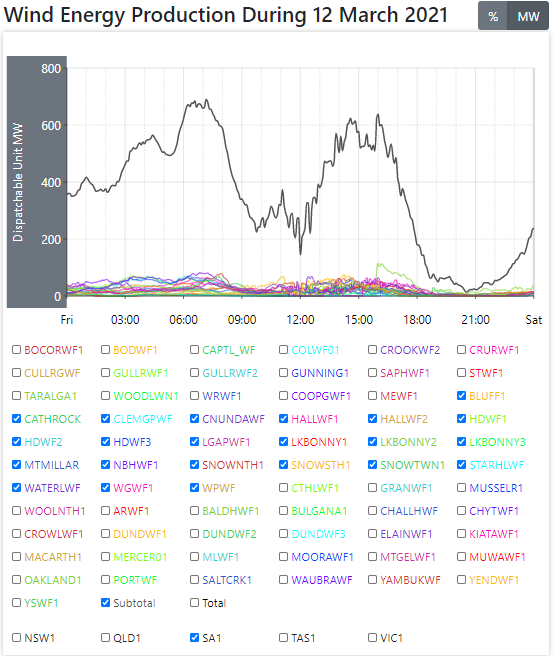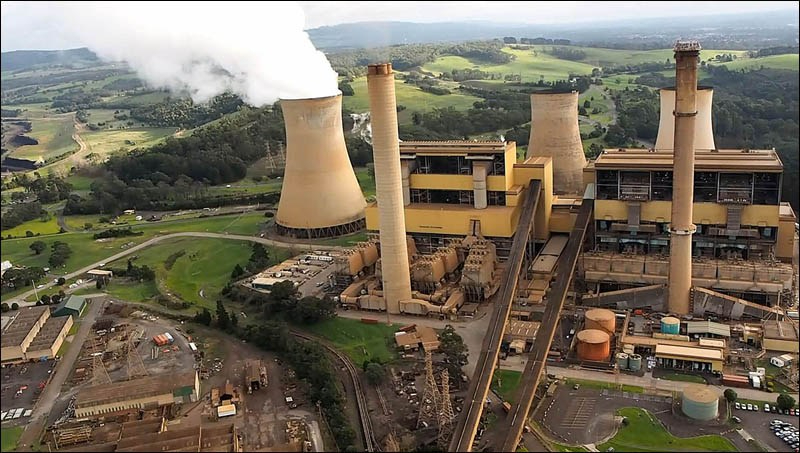
Want rocketing power prices and an unreliable supply? Then, subsidised wind and solar is just made for you.
The very point of subsidies to wind and solar is to knock reliable, dispatchable generation sources, out of the game.
In wind and solar obsessed South Australia, that’s already occurred, with a vengeance: it blew up its perfectly reliable coal-fired power plant in November 2018.
Reduced to relying upon diesel-fuelled ship engines (referred to below as the Barker Inlet power station and Open Cycle Gas Turbines (also run on diesel), the economic backwater (with the highest unemployment rate in the country) has become the butt of international jokes. For good reason.
STT has covered the topic numerous times. And, in particular, what happens to wholesale power prices when wind and solar output collapses.
In this example, on 12 March a total collapse in South Australia’s wind power output (see above) coincided with a total collapse in solar power output (aka ‘Sunset’).
Far from being ‘powered’ by wind and solar, South Australia is as heavily reliant upon Victoria’s coal-fired power, as ever. And when the wind stops blowing and the Sun sets, wholesale power prices go through the roof. None of which would have occurred had it simply stuck with its coal-power plants and otherwise maintained its reliable power sources.
We’ll hand over to David Bidstrup for the details in South Australia self-inflicted renewable energy calamity.
The cost of a fragile grid
Catallaxy Files
David Bidstrup
March 15 2021
On the 12th of March a substation fire that caused the shutdown of the Barker Inlet 210 MW gas power station in Adelaide. The interconnector with Victoria was under maintenance with only half capacity available and the combined output from the SA wind and solar stations fell to 2 percent of the rated capacity. Wholesale prices went through the roof with the maximum price per MWh reaching $14,348.00.
The six hour period between 6 p.m. and midnight cost $42,337,000.00 for 9,201 MWh giving an average cost of $4,596.00 per MWh. For the 18 hours prior to the interruption the average cost was $26.60 per MWh. The total for the entire day was $42,958,000.00 so the 6 hour period accounted for 98.7% of the days cost and 86% of the month to date cost.
Looking at the month of March up to the end of the 14th, yields the following chart:

Note that the data is for each half hour period so for 14 days there are 672 data points on the X axis.
Overall the average wholesale price per MWh for March 1 to 14 incl. is $152.00 with a maximum of $14,348.00 and a minimum of -$628.00. All the other parasites have to add their cut before the public pay the bill.
Catallaxy Files
Power prices surge in SA after fire at AGL Energy’s Barker Inlet power plant
The Australian
Perry Williams
14 March 2021
Wholesale electricity prices in South Australia surged more than 300-fold on Friday night after a fire knocked out AGL Energy’s Barker Inlet gas-fired power plant and the Victorian interconnector was down for repairs.
Wholesale power prices jumped to the maximum $15,000 a megawatt hour cap as a series of events briefly threatened the stability of the grid, strengthening calls for a planned interconnector to be built between South Australia and NSW.
A volatile few hours started at 6pm on Friday when a fire broke out at a Torrens Island electricity substation owned by state transmission operator ElectraNet.
That forced the shutdown of AGL’s 210MW Barker Inlet gas plant for the next 24 hours and output was also lowered at its much larger Torrens Island gas station due to safety concerns raised by the Australian Energy Market Operator.
The Heywood interconnector, which links South Australia to Victoria, had only half of its supply available due to a planned week-long outage, while the combined contribution from wind and large-scale solar fell as low as 2 per cent of the state’s installed capacity.
Several emergency generators were called into action and a hugely volatile period of pricing ensued over the following six hours to midnight, with 28 pricing dispatch intervals exceeding $10,000/MWh, according to data from consultancy GlobalRoam.
One of the big reasons for the price spikes was the lack of supply that could be imported from Victoria due to work on the damaged Heywood interconnector, underlining the difficulty of carrying out repairs in a tight market.
“The national electricity market is fast becoming a place whereby it’s very, very difficult to schedule and carry out critical network development — and maintenance and repair in this case — because of the increasing reliance on support from elsewhere, and multiple aspects of the weather,” said Paul McArdle at GlobalRoam. “It’s also going to mean that an unexpected failure or outage on any key part of the network ratchets up the level of risk considerably.”
[Note to Paul: what about the failures that coincide with sunset and calm weather, as depicted above? Or are they simply “expected failures”?]
Maintenance work on the Victorian interconnector line was halted by AEMO on Friday night in response to the fire and started again on Saturday morning.
Still, South Australia Infrastructure Minister Corey Wingard said the events showed why the 900km NSW-SA power link known as EnergyConnect, and worth $2.4bn, needs to be built.
“This is exactly why we’re looking at the interconnector. We know that’s the way to bring surety into the system,” Mr Wingard told media.
“The Marshall government’s plan is to close our power stations here in South Australia and become completely reliant on interstate generation by interconnection mixed with our renewables. Hardly a plan for growth and self-sufficiency,” Mr Koutsantonis said on Twitter.
South Australia last year accelerated a timeline for renewables to provide 100 per cent of its electricity needs with plans to hit the ambitious target by 2030.
The state already relies on solar, wind and storage for half its electricity generation but Energy Minister Dan van Holst Pellekaan wants to fast-track a shift towards clean energy.
AGL noted Barker Inlet was fully operational again by midnight Saturday. ElectraNet said part of its substation was damaged.
The failure of the South Australian and Victorian interconnector in the 2019-20 summer saw emergency costs soar but conditions improved this past summer amid low demand and fewer outages.
The federal government’s Energy Security Board has previously raised concerns about the reliability of the nation’s power grid, downgrading it to critical status as severe weather and ageing coal plants raise new system risks.
EnergyAustralia’s decision last week to shut Victoria’s Yallourn coal plant four years early saw the ESB warn Australia’s remaining coal fleet could be forced to close earlier than expected as low wholesale prices and cheap renewables rout generators’ profits.
The Australian


When power is needed from another state and that state has none to spare, what happens?
Victoria, NSW and Qld are all in the ‘gerbil warming’ scam, so are planning on closing fossil fueled plants. At this stage it looks like Qld will still have some coal fired plants for years to come but they should and hopefully will ensure that Qld gets the power first and bugger every other state.
All unreliables require backup. That is a fact that the zealots cannot deny, although they obfuscate by saying that ‘old’ coal firef units are unreliable. They and the MSM ignore the FACT that unreliables are called unreliables for a reason. They cannot guarantee supply at any given time, day or night. The RE zealots ignore facts that do not suit their ideology.
SA is usually importing power at breakfast and dinnertime. Right now there is next to no wind, local gas is providing two thirds of the demand and imported power is providing almost a third. Coal power from Victoria:)
https://catallaxyfiles.com/2021/03/25/the-hard-part-of-getting-to-net-zero-demonstrated-by-south-australia/